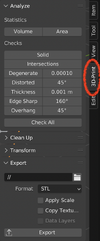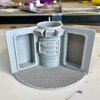JCalhoun
Well-Known Member
I’m starting, again, to try and build a Space Tug model from scratch.
The space tug was one of those things that NASA and other space visionaries in 1970 believed the U.S. would have as part of its regular space fleet — sometime before the 1980’s, of course. (Below: the green line was roughly where NASA was when I came across this in a book as a kid, the space tug is circled in red.)

When I was a kid growing up in the 1970’s I would occasionally come across depictions of this quirky utility spacecraft in the various books about space that I would check out from the library. Always some artist’s concept of course since it never saw the light of day. Damn, but I wish there had been a plastic model of that space tug when I was a kid.

And so my hobbies as an adult, it seems, focus more and more on creating some of those things that I wish had existed.

Some years back I made an effort to scratch-build a space tug using what you might call ILM techniques (acrylic substrate, lots of styrene, greebly details). It started out okay but I lost some of my initial enthusiasm as small problems crept up. (I posted my aborted attempt here.)
With 3D resin printers having become affordable and able to reproduce such fine detail, I thought I would have a go at creating a space tug again. This time though it would be without acrylic, styrene or even greeblies. I was going to try and model it all in Blender (the open source application), 3D print it in resin.
Sometimes too when I start on a project the goal is as much to learn new skills and gain some new knowledge. If a space tug model results, that’s excellent. (And I have often learned plenty even from the abandoned projects.)
If some of you have mastered CAD programs, that’s cool. I know Blender is not a CAD app, was not intended to be, but the price was right (ha ha) and learning Blender was one of those new skills I was hoping I could bundle into this project. (And hey, Blender can also handle sculpting, animating, rendering if I should wish to expand to those areas later.)

And yeah, since a space tug is more or less a cylinder with windows and a couple of manipulator arms, it seems like a pretty reasonable project to wade into both Blender and 3D printing as well.
The space tug was one of those things that NASA and other space visionaries in 1970 believed the U.S. would have as part of its regular space fleet — sometime before the 1980’s, of course. (Below: the green line was roughly where NASA was when I came across this in a book as a kid, the space tug is circled in red.)
When I was a kid growing up in the 1970’s I would occasionally come across depictions of this quirky utility spacecraft in the various books about space that I would check out from the library. Always some artist’s concept of course since it never saw the light of day. Damn, but I wish there had been a plastic model of that space tug when I was a kid.
And so my hobbies as an adult, it seems, focus more and more on creating some of those things that I wish had existed.
Some years back I made an effort to scratch-build a space tug using what you might call ILM techniques (acrylic substrate, lots of styrene, greebly details). It started out okay but I lost some of my initial enthusiasm as small problems crept up. (I posted my aborted attempt here.)
With 3D resin printers having become affordable and able to reproduce such fine detail, I thought I would have a go at creating a space tug again. This time though it would be without acrylic, styrene or even greeblies. I was going to try and model it all in Blender (the open source application), 3D print it in resin.
Sometimes too when I start on a project the goal is as much to learn new skills and gain some new knowledge. If a space tug model results, that’s excellent. (And I have often learned plenty even from the abandoned projects.)
If some of you have mastered CAD programs, that’s cool. I know Blender is not a CAD app, was not intended to be, but the price was right (ha ha) and learning Blender was one of those new skills I was hoping I could bundle into this project. (And hey, Blender can also handle sculpting, animating, rendering if I should wish to expand to those areas later.)
And yeah, since a space tug is more or less a cylinder with windows and a couple of manipulator arms, it seems like a pretty reasonable project to wade into both Blender and 3D printing as well.




